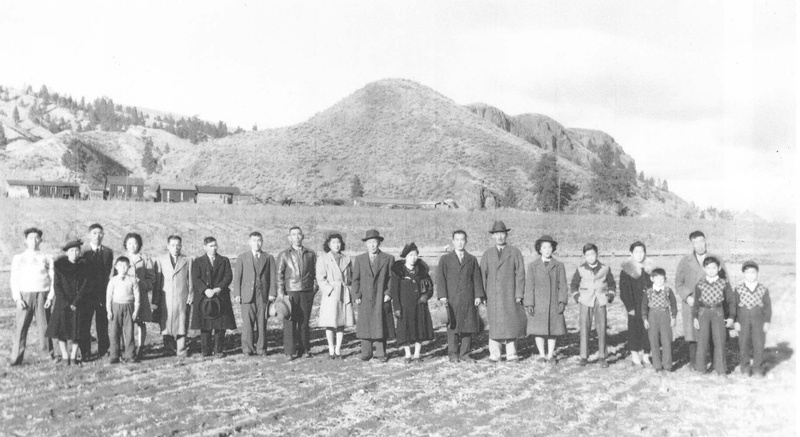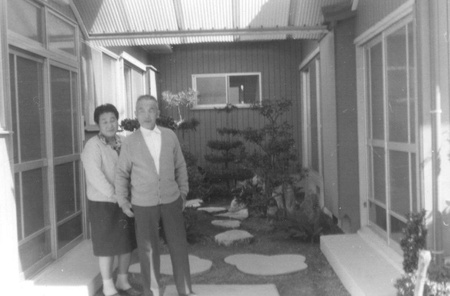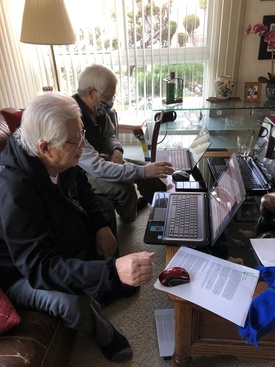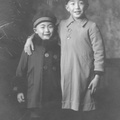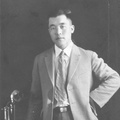Forced Exile to Japan
Kanshiro Koyama was relieved. Now what is ahead for him? Would he be allowed back to the West Coast? South of the border, the Japanese Americans were freed to move about anywhere including the Coast even before the war was over.
He waited. Meanwhile through the International Red Cross, he found out his family were safe and had survived the bombings.
He waited. But the news that he wanted to hear never came. Another year passed without Japanese Canadians being permitted to return to the Coast. So he decided to call it quits and in 1947 arrived back in Japan aboard a Canadian government ‘repatriation’ ship, never to return to the land that he learned to love and to fish and farm.
Finally, in 1949, the Japanese Canadians' full rights of citizenship were restored. Travel restrictions were lifted, they were allowed to vote again and permitted to return to the West Coast. Why did the Government take all of four years to restore their rights to these people of honor and loyalty? Dad wanted to come back to the Coast as soon as the war was over. He waited until 1947.
Before my Dad boarded the ship headed back to Japan, he used everything he had saved in the bank and turned it into consumables, clothing, coats, jackets, and suits. Plus hundreds of pairs of men and women's shoes boots, from a Coleman stove to a Singer sewing machine, even multi-gear English bikes for his sons. He knew that he was going to find his country in total ruins and a shortage of goods and food.
He even pre-ordered a big trunkful of salted salmon, and another trunkful of salted salmon eggs. By the time he reached the port of Uraga, his belongings alone took one entire train’s freight car.
Towards the end of the war, I had contracted typhoid fever which almost took my life. With hardly any medicine available, how I ever survived is a miracle in itself. I was told by nurses that I was brought to an isolation hospital by townspeople who carried me strapped me down onto a storm door. They told me that I went berserk because of high fever and did quite a lot of damage. I was hovering between life and death for one week and when I came to, a nurse was massaging my thigh as she was feeding me with an IV.
I lost all my hair but that is all. I made it through and my Mom must have exhaled a sigh of relief. She couldn’t lose one of his sons before Dad came home. She had done her job well.
We all take everything for granted, but to me my mother was more than a mere mother. I pray every day and night conveying my gratitude for what she did throughout her life: not only caring for us through our childhood but doing all she could when money stopped coming in and then moving 11 times and surviving through the bombings, the food shortage, and the need to put a roof over our heads, with no money. She had to sell a lot of her pretty kimonos and jewelry.
My Dad could be thankful that two of his children and his wife were well when he stepped off the ‘repatriation’ ship.
To be honest, when I was growing up, I could not remember what my Dad looked like. I recalled I went to Kobe to send him off a couple times when we were small but when I tried to recall his face, it was blank. Now in 1947 I met my Dad for keeps and so I stared at him good. He was not a bad looking man. He didn’t look like a typical Japanese. We didn’t know how to behave in front of our father since we had not had that luxury for too many years.
When Dad came home everyone knew that he brought back a bunch of goodies with him. Many aunties and uncles lined up outside our house to receive a gift or two because they knew my dad was a nice guy.
In the early days after his forced exile from Canada, he tried his best to settle down into war-torn Japan. Although rebuilding had started, everywhere you looked there were still ruins. Even the cities of Osaka and Wakayama were full of the steel skeletons of tall commercial buildings.
In those days immediately after the end of war my dad was taken advantage of by some unscrupulous men. He had spent a good portion of his life conducting business in Canada on a relatively high moral level, and now those Japanese men saw right through him. His attempts to start a business was met with one failure after another.
When he noticed that money was running low he started selling all the shoes and clothing he had brought back. He even sold our multiple-gears English bikes telling us that riding in town would be dangerous. Even if we had the only one of their kind in the whole of Japan, that might be unsafe for us to keep, so they were sold. I didn’t object too much.
About this point in Dad’s life, his personal life was starting to fall apart, and my mom and dad went through a divorce. In Japan in those days, it was almost unheard of. A divorce in a family meant the children would be subjected to ridicule, prejudice and their chances of getting decent employment would be almost impossible. I didn’t know at the time that it was going to haunt me and my brother for a long time.
My dad after the divorce was a changed man due to the difficult circumstances. The longtime love of his life was gone, and his years of working so hard and successfully in Canada were fading away. He decided to move back to Mio-mura where he was born and where he had started his odyssey to Gabriola Island, Nanaimo, and Kamloops some 40 years ago.
He took up farming to raise a portion of what he needed to feed two sons. He also eventually met a new woman from a neighboring town, and brought her into his family. However, my brother did not like this new situation, and decided to run away and eventually moved in with our real mom. My dad asked me what I wanted to do, and since our family was split in two and my older brother was with Mom, I decided that I would stick with my dad.
Sometimes you have to overlook what parents do or don’t do. When it happened I tried to concentrate on my tasks on hand. That was my schooling. I was finishing my junior high education in the tiny village of Mio-mura.
Yosh Grows Up
I applied myself persistently and without any reservation. I used to listen to ARMED FORCES RADIO network and in any spare time I would read the Bible. I read somewhere that to truly understand the West and America you need to understand Christianity.
So I studied and studied trying to even memorize the whole dictionary. On one occasion I had an opportunity to participate in a Wakayama High School English Oratorical Contest at nearby Shingu High School. I finished with honors, and I appreciated the assistance from a NikkeiAmerican woman who taught me enunciation.
When I finished my high school, it was time to apply for the best work available for graduates. In those days it was working for Import/Export Trading firms in Osaka. So we along with other graduates applied for the entrance exams with the top trading company in all of Japan at that time. It consisted of two parts; the first academic and second interviews. I passed the academics with flying colors and was only one oftwo finalists so my chances were good, so I thought.
Then came the interviews and that was when they brought up my parents’ divorce.
I did not get the job.
Disillusioned and disgusted, I had to find something to do to earn a living. So I set out to Osaka, rented a small room, and looked for any kind of work. I found a job at the Air Force Base in nearby Itami. There I made a good friend, a Navy chaplain, who helped me with my entry into the US.
Meanwhile Dad contacted his older brother in Los Angeles and asked him to be a sponsor for my entry into the USA.
Was there a reason why I studied English so earnestly with such a feverish pace? I didn’t have any inkling of what lay ahead in my life. Was there a reason why I was introduced to the Bible? Why was I attracted to church? Was this divine guidance from above? Did l pick Christianity just to be spiteful to Mom’s religion?
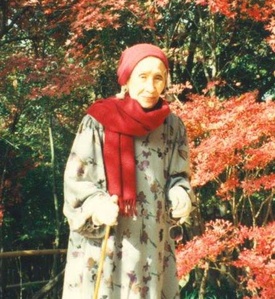
I was brought up by a mom who possessed supernatural spiritual power in Buddhism and I was positive she wanted us children to follow her religion. Yet, I was surprised when she encouraged me to choose any kind of faith of my own choosing and with her blessing. She eventually departed from her Buddhist sect and formed her own church in Wakayama, the Rippo-Kyodan with a thousand members. She was treated as one of the Spiritual Leaders of Japan. She died in 1999.
I was given a visa and my dad had enough Canadian dollars left in the bank to mail to my uncle to sponsor me. So I set sail to a new country. I thought it was going to be Canada, but it was the USA. No one cares about my family history here. This is the land of the free. Finally, I am free.
But I did encounter discrimination and hatred when I came here and enrolled in an English literature class at a theological college. One day, out of a clear sky, and to my shock, a female professor said that "Japanese are sub humans”. I found out later that her husband was a conscientious objector during the war. It was in 1954 or 55. My classmates were dumbfounded, and they did not say a word. I eventually left that college. It was hard for Nikkei in those days.
About that time I married Kay, a Sansei Japanese American. I worked at a photo engraving company where I experienced the same harsh discrimination. Then my boss who had been a US marine in the Pacific war interceded and challenged the guy who called me “a dirty yellow Jap”, and made him apologize to me. After that my boss and I became the best of friends.
Meanwhile
Kanshiro Koyama was cooped up in the tiny village of Mio-mura, making barely enough to get by, raising vegetables and gathering firewood. He was almost 60 years old then. I decided I had to do something to bring him over here to the US.
There was an opportunity for him to come as a refugee. A US agency went to Mio-mura and interviewed and qualified him. I invited him to forget his heartbreaks and come to live with us in warm sunny California.
So he came with my Step-Mom. I was under the impression they would stay for a while. But I was wrong. He worked hard and saved enough to return to Mio-mura after 7 years here, and then went back and built a brand new western-style home.
On his return to Mio-mura, he was content. His children, one here in the US and another in Japan, have made contributions to their respective countries, as have their children and grandchildren. Koyama Fish Camp became Page's Resort & Marina and still flourishes as a family business, proud to acknowledge him as founder. After going through war, through racial hatred, prejudice and discrimination, but with love and friendship along the way, he died in 1975.
* * * * *
Afterword by Timothy Koyama
Recently retired, I have had time to delve into family history. When I was a young boy in the mid-1960s, my father, Yosh Koyama, took us on multiple vacations to Nanaimo, BC, where I was told that my grandfather, Kanshiro Koyama, was a fisherman. In my college years in the early 1980s, my father took us on a vacation to an old fishing village called Mio-mura, in Wakayama, Japan, where my grandfather is buried, and the lighthouse there flies both the Japanese and Canadian flags. I was told by my father that he spent some of his childhood years there, and that there are strong ties between this Japanese fishing village and Canada.
Recently, I did an internet search on the words Japanese, Canadian, and Koyama. Interestingly, I came across a story written in 2017 by the Gabriola Museum in BC on a Koyama Fish Camp, and its being on a list of historic sites with significance to Canadians of Japanese descent. Furthermore, the owner of the fish camp was identified as Kanshiro Koyama back in 1934. I also found a supporting reference, written by Phyllis Reeve, mentioning that there was no knowledge of the whereabouts of Kanshiro Koyama during and after WWII.
I emailed my father, now 87 years old and suffering from COPD and severe spinal stenosis. I inadvertently opened up some old wounds. My father’s story is difficult to believe, and includes many family struggles and tragedies during a difficult time in our world history. But his story also includes rebuilding and starting anew, and explains how he came to be here in Los Angeles. Painfully, both emotional and physical, he wrote his story as a family legacy to me and future generations.
For this, I am truly thankful. Arigato.
*This article, written by Daniel “Yosh” Koyama with Timothy Koyama and Phyllis Reeve, was originally published in the Nikkei Images, Vol 26, No. 1.
© 2021 Daniel "Yosh" Koyama




